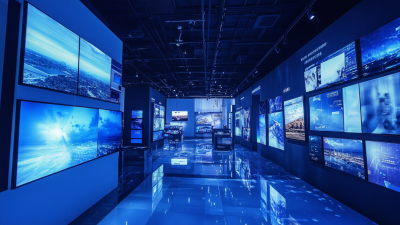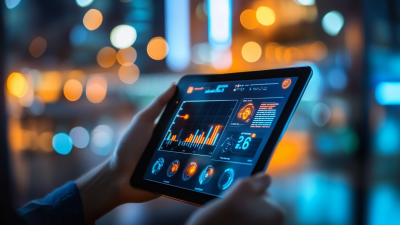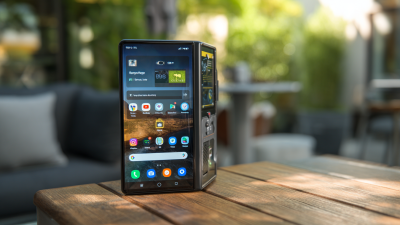Leave Your Message
In today's rapidly evolving world of renewable energy solutions, the role of technology is pivotal in enhancing efficiency and user experience. One of the standout innovations in this domain is the Hybrid Inverter LCD Display, which serves as a bridge between complex energy management and user-friendly interface. This advanced technology not only optimizes energy storage and usage but also provides real-time monitoring and control, making renewable energy more accessible to everyday consumers.

As we delve into the versatility of the Hybrid Inverter LCD Display, we will explore its applications, benefits, and how it empowers users to make informed decisions about their energy consumption. This blog aims to guide you through the various functions and advantages of this innovative technology, highlighting why it is becoming an indispensable component in modern energy solutions.
In the realm of renewable energy, hybrid inverters have emerged as pivotal devices, particularly due to their innovative LCD displays. These displays play a crucial role in enhancing the efficiency of renewable energy systems by providing real-time data and analytics. Users can easily monitor energy production and consumption, allowing for better decision-making and optimization of energy resources. By visualizing critical information such as battery status, energy generation, and load management, LCD displays empower consumers to maximize their use of renewable energy.
Moreover, hybrid inverter LCD displays facilitate greater user interaction with the energy system. They can offer diagnostic insights, alerting users to potential issues before they escalate. This proactive approach not only enhances system reliability but also contributes to longer equipment lifespans and improved overall efficiency. As renewable energy solutions become increasingly complex, the intuitive interfaces provided by these LCD displays simplify the user experience, making sustainable energy more accessible to homeowners and businesses alike. This blend of practicality and intelligence represents a significant stride forward in the drive towards efficient and effective renewable energy management.

The inclusion of LCD displays in modern hybrid inverters has significantly transformed the efficiency and usability of renewable energy systems. These displays provide real-time monitoring of key performance metrics such as energy production, consumption, and system status. According to a report by Navigant Research, the global market for hybrid inverters is expected to grow by more than 40% in the next five years, underscoring the increasing demand for advanced monitoring solutions that enhance user interaction and control.
One of the standout benefits of hybrid inverter LCD displays is their ability to simplify complex data. Users can easily interpret energy flow and management statistics, which can boost system performance and lifespan. Furthermore, features like customizable alerts and diagnostics make proactive maintenance more accessible, contributing to overall system reliability. As per a study from Grand View Research, incorporating smart features into energy systems can yield a 20-30% increase in operational efficiency.
**Tip:** Regularly check your hybrid inverter’s LCD display to stay informed about your energy use patterns and identify any irregularities in performance.
In addition, many modern displays are designed with user-friendly interfaces, enabling homeowners and businesses to harness energy more effectively. As the renewable energy landscape shifts towards more integrated solutions, having an intuitive display can enhance user engagement and sustainability goals.
**Tip:** Invest in hybrid inverters with upgrades for future technologies, ensuring the LCD display remains compatible with emerging renewable energy innovations.
The integration of LCD display technology in hybrid inverters plays a pivotal role in enhancing user interaction and system monitoring within modern renewable energy solutions. As the demand for efficient energy management systems continues to rise, recent market reports indicate that the adoption of hybrid inverters is expected to grow at a compound annual growth rate (CAGR) of 12.5% from 2023 to 2030. This surge can be largely attributed to the advancements in user interface technologies, specifically LCD displays, which provide real-time data on energy production, storage levels, and consumption patterns.
LCD displays empower users with intuitive interfaces that translate complex data into accessible information. A study by the International Energy Agency (IEA) found that systems equipped with advanced LCD displays witnessed a 20% improvement in user engagement, leading to more informed energy usage decisions. Furthermore, these displays facilitate remote monitoring capabilities, allowing users to track performance from anywhere, thereby maximizing operational efficiency. With features such as touch-screen controls and customizable dashboards, the interaction with hybrid inverters becomes seamless, making renewable energy more user-friendly and accessible than ever before.

The rise of renewable energy has prompted a thorough examination of hybrid inverters and their advantages over traditional inverter systems. Hybrid inverters, capable of integrating solar energy with battery storage, deliver enhanced performance and efficiency crucial for modern energy demands. Research indicates that three-phase transformerless inverter configurations, often utilized in solar photovoltaic (PV) systems, achieve efficiency rates exceeding 98%. This high efficiency is particularly critical in maximizing energy output, especially given the significant fluctuations in solar generation due to weather conditions.
Moreover, advanced control strategies like nonlinear Maximum Power Point Tracking (MPPT) techniques enable hybrid power systems to maintain optimal performance across diverse operational scenarios. This adaptability is essential as the global energy landscape shifts towards greater reliance on renewables. The enhanced frequency stability offered by grid-forming inverters, coupled with innovative model predictive control approaches, ensures that these systems can efficiently integrate with existing grids, thus supporting the transition to sustainable energy solutions. As reported, the growing adoption of renewable energy sources is reshaping grid infrastructure, further emphasizing the superiority of hybrid inverter systems in achieving energy resilience and reliability.
| Feature | Hybrid Inverters | Traditional Inverters |
|---|---|---|
| Efficiency | 95% - 98% | 90% - 95% |
| Energy Storage Capability | Yes | No |
| Load Conversion | Automatic | Manual |
| Smart Grid Compatibility | Yes | Limited |
| Installation Complexity | Moderate | High |
| Cost | Higher Initial Cost | Lower Initial Cost |
| Maintenance | Low | Moderate |
As the demand for renewable energy solutions continues to rise, hybrid inverter LCD displays are evolving to meet the needs of modern energy systems. These displays provide users with real-time data on energy production and consumption, enabling them to make informed decisions about their energy usage. Future trends indicate a shift towards more intuitive interfaces that will enhance user experience, making energy management accessible to a broader audience. Integration with smart home technology is anticipated, allowing for seamless monitoring and control of energy systems from mobile devices.
Moreover, advancements in display technology will lead to more sophisticated features, such as predictive analytics and machine learning algorithms that optimize energy efficiency. By leveraging data from various energy sources, hybrid inverters will not only display information but also provide actionable insights to maximize renewable energy use. The fusion of renewable energy with intelligent display systems ushers in a new era of energy sustainability, positioning hybrid inverters as pivotal components in the transition to greener energy solutions.






